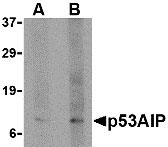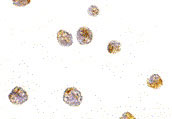p53AIP1 Antibody
- 产品详情
- 实验流程
- 背景知识
Application
| WB, IF, ICC, E |
|---|---|
| Primary Accession | Q9HCN2 |
| Other Accession | BAB16421, 10798768 |
| Reactivity | Human |
| Host | Rabbit |
| Clonality | Polyclonal |
| Isotype | IgG |
| Calculated MW | 12935 Da |
| Conjugate | Unconjugated |
| Application Notes | p53AIP1 antibody can be used for detection of p53AIP1 by Western blot at 4 - 8 µg/mL. Antibody can also be used for immunocytochemistry starting at 10 µg/mL. For immunofluorescence start at 20 µg/mL. |
| Gene ID | 63970 |
|---|---|
| Other Names | p53AIP1 Antibody: P53AIP1, p53-regulated apoptosis-inducing protein 1, p53AIP1, tumor protein p53 regulated apoptosis inducing protein 1 |
| Target/Specificity | TP53AIP1; |
| Reconstitution & Storage | p53AIP1 antibody can be stored at 4℃ for three months and -20℃, stable for up to one year. As with all antibodies care should be taken to avoid repeated freeze thaw cycles. Antibodies should not be exposed to prolonged high temperatures. |
| Precautions | p53AIP1 Antibody is for research use only and not for use in diagnostic or therapeutic procedures. |
| Name | TP53AIP1 |
|---|---|
| Function | May play an important role in mediating p53/TP53-dependent apoptosis. |
| Cellular Location | Mitochondrion. |
| Tissue Location | Only found to be expressed in thymus. |
For Research Use Only. Not For Use In Diagnostic Procedures.
Provided below are standard protocols that you may find useful for product applications.
BACKGROUND
p53AIP1 Antibody: The p53 tumor-suppressor protein can induce apoptosis through transcriptional activation of several genes. One such protein p53AIP was initially identified through direct cloning of p53 binding sequences from human genomic DNA. Its expression is inducible by p53 following p53 phosphorylation on Ser-46, and ectopic expression of p53AIP leads to apoptotic cell death. Both the phosphorylation of p53 and the induction of p53AIP were blocked by inhibiting the expression of p53DINP1 by the introduction of antisense oligonucleotides to p53DINP1, suggesting that the apoptosis associated with p53AIP expression is regulated by p53DINP1. Finally, as adenovirus-mediated introduction of p53AIP has been shown to suppress tumor growth in vivo, it has been suggested that p53AIP gene transfer may become a useful strategy for the treatment of p53-resistant cancers. Three isoforms of p53AIP are known to exist; this antibody will detect all three.
REFERENCES
Kern SE, Pietenpol JA, Thiagalingam S, Seymour A, et al. Oncogenic forms of p53 inhibit p53-regulated gene expression. Science1991; 252:1708-11.
Oda K, Arakawa H, Tanaka T, et al. p53AIP1, a potential mediator of p53-dependent apoptosis, and its regulation by Ser-46-phosphorylated p53. Cell2000; 102:849-52.
Okamura S, Arakawa H, Tanaka T, et al. p53DINP1, a p53-inducible gene, regulates p53-dependent apoptosis. Mol. Cell2001; 8:85-94.
Yoshida K, Monden M, Nakamura Y, et al. Adenovirus-mediated p53AIP1 gene transfer as a new strategy for treatment of p53-resistant tumors. Cancer Sci.2004; 95:91-7.
终于等到您。ABCEPTA(百远生物)抗体产品。
点击下方“我要评价 ”按钮提交您的反馈信息,您的反馈和评价是我们最宝贵的财富之一,
我们将在1-3个工作日内处理您的反馈信息。
如有疑问,联系:0512-88856768 tech-china@abcepta.com.























 癌症的基本特征包括细胞增殖、血管生成、迁移、凋亡逃避机制和细胞永生等。找到癌症发生过程中这些通路的关键标记物和对应的抗体用于检测至关重要。
癌症的基本特征包括细胞增殖、血管生成、迁移、凋亡逃避机制和细胞永生等。找到癌症发生过程中这些通路的关键标记物和对应的抗体用于检测至关重要。 为您推荐一个泛素化位点预测神器——泛素化分析工具,可以为您的蛋白的泛素化位点作出预测和评分。
为您推荐一个泛素化位点预测神器——泛素化分析工具,可以为您的蛋白的泛素化位点作出预测和评分。 细胞自噬受体图形绘图工具为你的蛋白的细胞受体结合位点作出预测和评分,识别结合到自噬通路中的蛋白是非常重要的,便于让我们理解自噬在正常生理、病理过程中的作用,如发育、细胞分化、神经退化性疾病、压力条件下、感染和癌症。
细胞自噬受体图形绘图工具为你的蛋白的细胞受体结合位点作出预测和评分,识别结合到自噬通路中的蛋白是非常重要的,便于让我们理解自噬在正常生理、病理过程中的作用,如发育、细胞分化、神经退化性疾病、压力条件下、感染和癌症。








